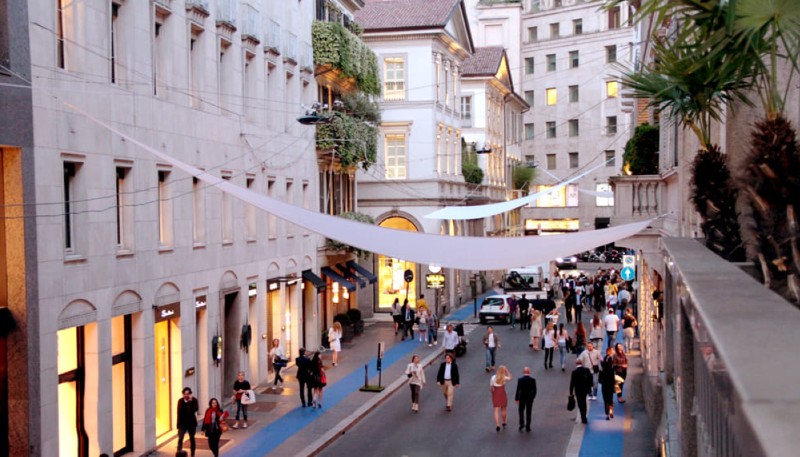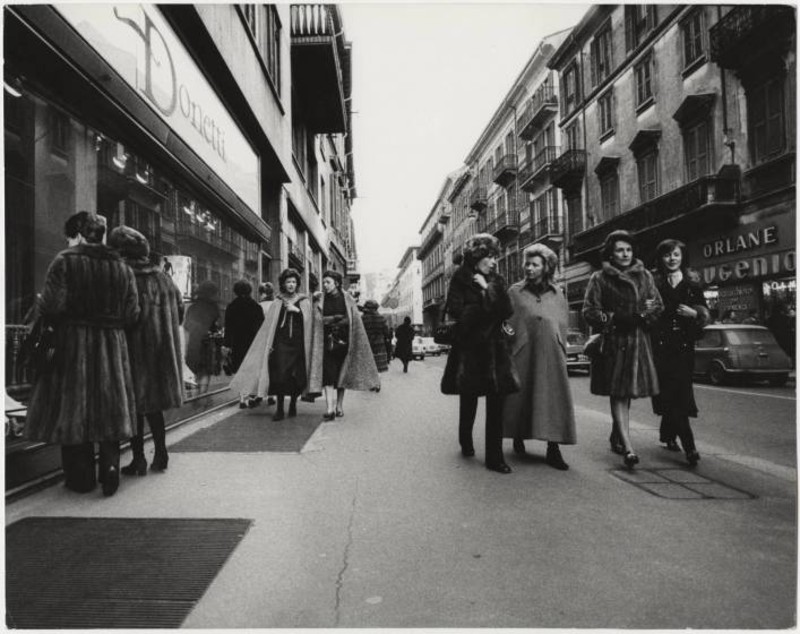
Via Montenapoleone
Via Montenapoleone is the backbone of Milan’s consumerist fashion circuit

Via Montenapoleone today
(Via). The backbone of the Milanese fashion retail circuit. As Guido Lopez and Silvestro Severgnini relate in Milano in mano (published by Mursia), the street “runs along the ditch that still survives underground, which surrounded the Roman walls. Some traces of it still remain here and there in the cellars of the odd-numbered side of the street.” The fashion bulldozer has transformed what Van Wood once defined in a song as “the living room of Milan” into an obsessive parade of shoes, miniskirts, suits, bolero jackets, blouses, cashmere, outfits for professional men and women, bags, jewelry, and watches. It was natural and predictable that Italian prêt-à-porter, Milan’s great success story, would need a stage to promote its image, buying into streets that the banks had deprived of life. But there have always been strong protests about the transformation of the street that, after World War II, definitively replaced the Vittorio Emanuele Gallery as a meeting point, a central axis for walking and a place to “do lengths,” as going up and down Via Montenapoleone came to be known in 1950s slang.
Implementation of Boulevard Mont Napoleon
Indeed, it was in 1950 that a great Milanese author, Raffaele Calzini, began to complain: “In about 1920, it was a tranquil and noble street that attracted, at most, aristocrats and the solitary wealthy from Via Borgospesso, Via Santo Spirito, Via Gesù, and Via Sant’Andrea. For some inexplicable urban phenomenon, at first timidly, then more bravely, finally boldly, and afterwards even insolently, Via Montenapoleone competed with other elegant Italian streets: with the Florentine Via Tornabuoni, the Roman Via Condotti, Quattro Canti in Palermo, Via Chiai in Naples.” The criticisms, grumblings and regrets multiplied directly in relation to the fashion invasion.

Via Montenapoleone in the 1980s
Tears were shed in newsprint when, during the 1970s and 1980s, the drug store Parini, a sort of Milanese Fauchon in the field of spices and sauces, and the fruitsellers Moretti, whose goods sold at phenomenal prices, ceded to the opening of Valentino and the hosiery firm Fogal. The tears were even more heartfelt when Versace ousted Ricordi, the record store that had cradled, in the listening booths with headphones, the first loves of two generations, and when Salumaio, the gastronomic centre of Via Montenapoleone, accepted, comforted by a very large sum, to move into an inner courtyard to make space for the store front of Corneliani.
But during the 1920s and 1930s, lamented when Bottega della Poesia, a bookshop-cum-art gallery founded by Enrico Somaré, Emanuele Castelbarco, and Walter Toscanini, was forced to close, to be replaced by Marco, a fabric shop. The truth is, that long before the designer boom and the birth of Milan as the prêt-à-porter capital, Via Montenapoleone was, in terms of the relative number of shops, a fashion street. The metamorphosis was, above all, a slow one, with a gradual growth of designers, a development that followed an internal logic.
Read also:
THE VIA MONTENAPOLEONE HARVEST AMONG BEAUTIFUL CLOCKS AND EXCELLENT WINE

